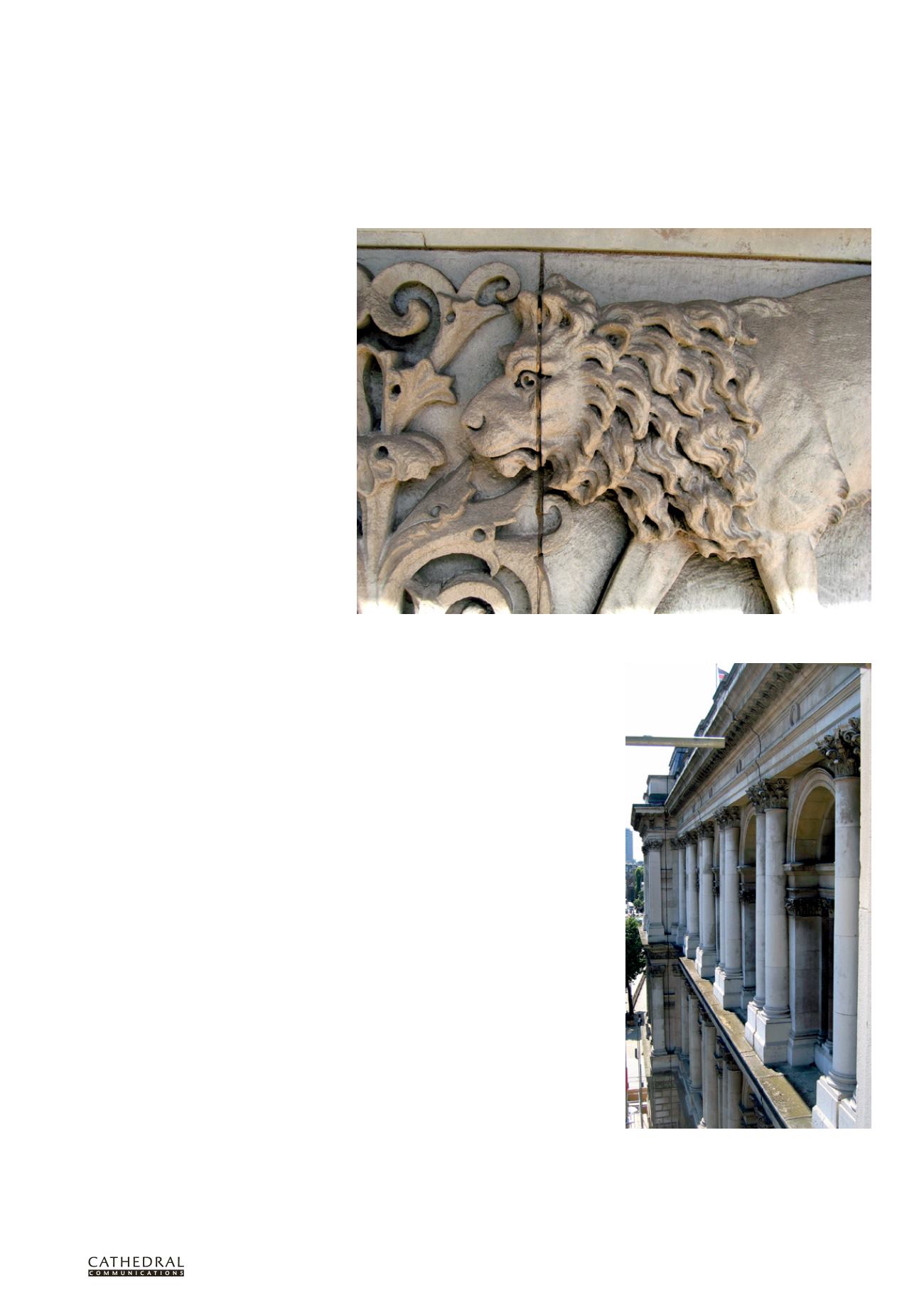

T W E N T Y S E C O N D E D I T I O N
T H E B U I L D I N G C O N S E R VAT I O N D I R E C T O R Y 2 0 1 5
1 5 1
SERV I CES & TREATMENT :
PROTEC T I ON & REMED I AL TREATMENT
4.1
DECORATIVEMASONRYREPAIRS
CATHERINE WOOLFITT
A
N UNDERSTANDING
of the
characteristics of building stones
and their weathering and decay in
the external environment is fundamental to
effective repair of all types of historic masonry.
Specifiers need to anticipate the physical and
visual impact of any proposal to clean and
repair a historic building. They should also
bear in mind that cleaning and surface repair
normally require listed building consent and
all aspects of the proposed work, whether
aesthetic or technical, need to be considered.
Historic stonemasonry facades can present
a wide spectrum of challenges, and variations
in stone type, date, extent of weathering and
style of construction are all significant factors.
Broadly, the older the building and the greater
the extent of past repair and alteration, the
more complex and challenging the remedial
work is likely to be. Heavily decayed surfaces
can be particularly demanding, especially
when they are in exposed or inaccessible
locations, occur consistently across a facade, or
pose a threat to health and safety.
This article focusses on minor repairs to
decorative ashlar masonry – that is to say,
accurately dressed blocks with relatively fine
joints. It therefore excludes works to rubble
masonry, and major structural repair work
and concentrates on facades of functioning
buildings, excluding the ruined monument
context. Other masonry types and contexts
may present different challenges and will often
demand a different approach from ashlar.
SURVEY AND UNDERSTANDING
Condition survey is the first essential step
in the process of developing and planning
remedial work. The aim is to gather as much
information as possible about the nature of
the masonry, the building stones used and the
history of past repair work, and it is usually
carried out in several stages depending on
the level of access and whether cleaning is
involved. At the planning stage, a preliminary
survey from ground level with the aid of
binoculars may be sufficient to produce
remedial work documents (a specification,
schedule of work and budget costs), all of
which will normally be provisional to some
degree. For this reason it is common practice
to include a provisional sum for unforeseen
work, repair items which are difficult to detect
from ground level. At some stage, however,
a close-range detailed survey and condition
assessment will be necessary to produce an
accurate schedule of work with individual
repair items described and measured.
This detailed information is typically
obtained at the beginning of a contract once
scaffold access is available. Ideally, as much
information should be gathered in advance
of the contract as possible and aerial access
platforms or cherry-pickers, as well as
rope access specialists can be very helpful,
especially in cases where there are unusual
defects requiring further investigation.
The preliminary survey should consider
both the individual masonry elements and the
complete elevation, and an understanding of
surface condition and soiling is important.
Studying soiling patterns will reveal how
rainwater is shed, how masonry joints
function and where they fail to function
properly due to localised decay. Variation
and irregularity in the deposition of soiling
may relate to natural weathering but can also
result from stonemasonry defects. Patches
or streaks of clean stone in the midst of
soiling typically indicate localised rainwater
washing, which may relate to exposure, the
orientation of the facade, or environmental
conditions such as the prevailing wind and
proximity to other buildings or trees. Streaks
can also indicate the presence of defects such
as fractures or eroded perpendicular joints
(the ‘perpends’) in cornices or mouldings
which will eventually admit rainwater.
With time, rainwater penetration will
promote decay of the stone arrisses at open
joints. Once the mortar joint is completely
eroded, characteristic rain-washed streaks
will form on soiled stone surfaces below.
It is normal practice to carry out cleaning
work in advance of masonry repair for two
reasons. Firstly, depending on the extent and
nature of surface soiling, it can be difficult to
identify and assess defects without cleaning
Masonry joints through decorative elements and sculpture require special care in cutting out and placing
repointing mortar and in the design of a physically and visually compatible mortar.
The Whitehall elevation of the Foreign and
Commonwealth Office: survey should include
assessment of differential weathering and decay
across a masonry facade, from sheltered, recessed
areas to severe exposures, such as copings, cornices
and other projecting elements.
















